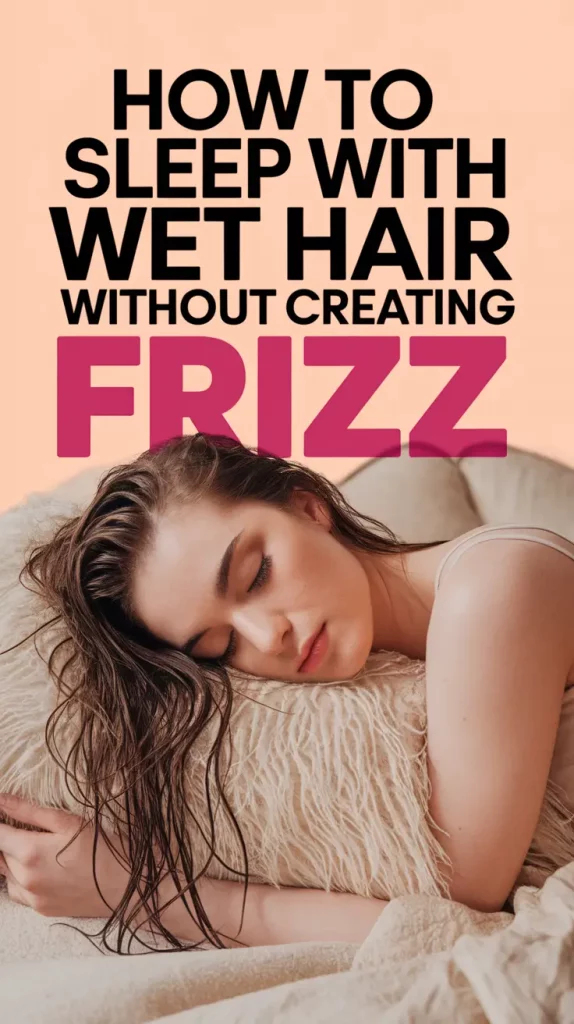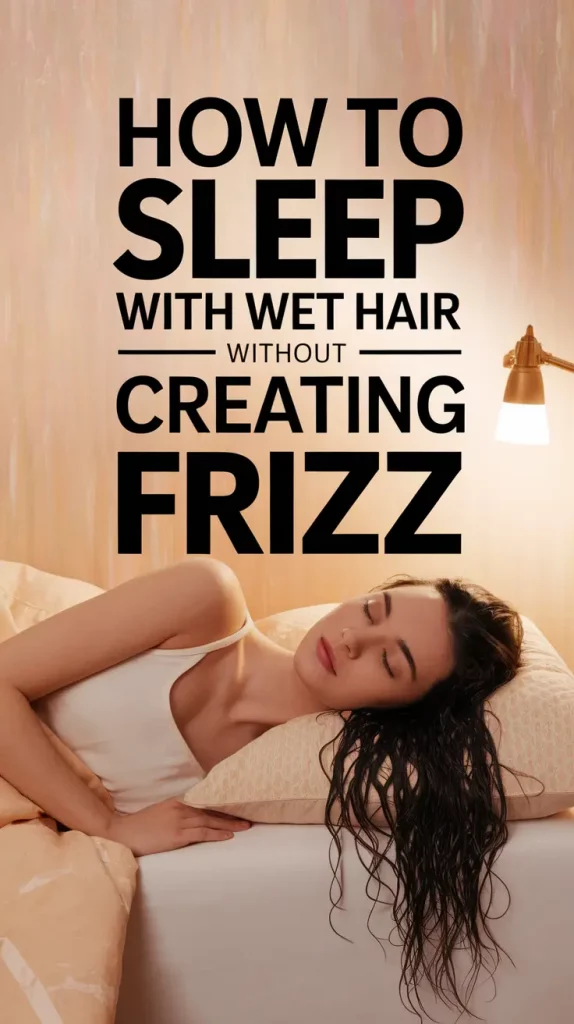It’s not the best feeling to wake up and find your hair is a mess. If you’ve ever gone to sleep with damp hair, you probably know what I’m talking about. I struggled for years to look after my hair at night without giving in to my tiredness and this always resulted in unmanageable, frizzy hair every morning.
And it’s not just me. A lot of us fall asleep with damp hair because it’s easy, but we end up with frizzy hair the next morning. So I started experimenting. Slowly. Cautiously. And now? I have a reliable routine that lets me sleep with wet hair and wake up with it looking smoother, healthier, and more put-together.
I’ll explain what made the difference and how you can finally get rid of bedtime frizz.
Why Wet Hair Turns Into Frizz Overnight

What I didn’t anticipate is that most of us blame our hair texture, when the real cause is lack of moisture and too much friction.
When your hair is wet, its cuticle (outer layer) is more vulnerable. Add the constant rubbing against a pillowcase as you sleep, and you’ve got the perfect storm for frizz. And once the cuticle lifts and gets roughed up? You lose that smooth, shiny finish we all want.
What Happens as You Sleep
- Moisture evaporates unevenly
- Hair rubs against cotton pillowcases
- Hair bends or knots in unnatural ways
I used to believe that my hair didn’t look good first thing in the morning. But no—it just needed support.
The Routine That Changed My Mornings
It started with something I thought I’d hate: letting go of my fluffy cotton towel. I swapped it for a microfiber turban one night, and everything shifted.
3 Steps That Helped Me Wake Up With Smooth Hair
- Use a microfiber towel: After showering, I gently squeezed out water with a soft microfiber wrap. No aggressive rubbing.
- Loose braids over tight buns: I divided my damp hair into two loose braids. Not tight, just enough to hold shape. This helped it dry evenly without frizz.
- Silk or satin pillowcase: Game-changer. It reduced friction and helped my hair glide instead of tangle.
That first morning? I ran my fingers through soft waves. No puff, no mess. A simple way to calm my hair and have an easier morning.
Prepping Wet Hair Before Bed: The Real MVP Move
This is where it all shifted. I realized the five minutes before bed matter more than I thought.
Usually, I feel like crashing as soon as I finish drying off. I discovered that doing a simple routine helps my hair stay much better during the night.
Things to Consider When Creating a Pre-Sleep Routine:
- Hair type: Fine, wavy, curly, thick—each needs different care.
- Time before bed: If you wash right before bed, go for more structure (like braids or buns).
- Products: Leave-in conditioner or light oil makes a big difference.
- How you sleep: Side sleeper? Back? That affects how your hair rests and moves.
Now, I take care of my hair with the same care I give to my skin. And wow, the payoff is real.
What Works (And Doesn’t): Tried-and-Tested Approaches
Let me show you how it all compares. I observed the changes in my hair texture after using the different approaches.
| Bedtime Method | Frizz Level | Final Result |
|---|---|---|
| Loose bun, cotton pillow | High | Kinks + halo frizz |
| Braids + silk pillowcase | Low | Soft waves, smooth |
| No prep, air dry freely | Very High | Puffy and tangled |
| Light oil + braid + silk | Very Low | Glossy, shaped |
My satin pillowcase and a simple braid made all the difference.
What If You’re Too Tired to Do a Full Routine?
The part I really understand is that sometimes, you’re just not up for it anymore.
I’ve had nights when I’m too tired to braid, oil or style my hair. Even so, a few small changes keep me from dealing with major hair issues when I wake up.
My Bare Minimum Routine:
- Gently blot hair with a microfiber towel
- Finger comb and apply a leave-in spray
- Twist hair into a soft top bun (held with a scrunchie)
- Lay down on a satin pillowcase
Even if you just make a few changes, these things will help reduce friction and keep moisture in the right place.
Mistakes I Used to Make (And Don’t Anymore)
I had to face the truth about myself at this point. I had some bad habits I didn’t even recognize.
- Sleeping on wet, dripping hair: It weighed down my strands and soaked my pillow.
- Using tight hair ties: They left dents and snapped strands.
- Brushing damp hair with the wrong tool: I was damaging it without realizing.
- Thinking cotton pillowcases were “fine”: Nope. They’re absorbent and rough.
Now I’m mindful—not perfect, but better. And it shows.

Products That Actually Help (No Overhype Here)
I tried a lot. Some were too heavy. Some did nothing. These, though, delivered real results.
- Argan or macadamia oil: A few drops on damp hair sealed my ends.
- Leave-in conditioner spray: Lightweight and kept frizz away.
- Microfiber hair wrap: Cut my drying time and gentled the process.
- Satin bonnet: If I’m not using a satin pillow, I slip this on instead.
You don’t need everything. But adding just one of these could shift your mornings.
What Hair Type You Have Does Matter
I wish someone had told me sooner that routines aren’t the same for everyone. What works for me might need tweaking for you.
General Guide Based on Hair Texture:
- Straight or fine hair: Go light on products. Braids or top buns help reduce pillow friction.
- Wavy hair: Braids help preserve wave pattern. Use a curl cream or light oil.
- Curly or coily hair: Pineapple method or protective styles (twists, braids) are great. Moisture is your friend.
Learning my own hair’s needs helped me customize everything else.
Ready to Try It? Here’s How to Start Tonight
If this all feels like a lot, start simple. When I know I’ll sleep on wet hair, I do the following:
- After showering, use a microfiber towel to gently blot
- Detangle with a wide-tooth comb
- Apply light leave-in conditioner or a few drops of oil
- Divide into two loose braids or a gentle bun
- Sleep on satin or wear a soft bonnet
Consistency wins here. If your results aren’t perfect at first, they will improve as you get used to the routine.
The Bottom Line
Sleeping with wet hair isn’t the enemy. Friction and poor prep are. As soon as I realized this, my mornings were calmer, my hair was healthier and my nights were less stressful.
Would you ever try this trick?
If you find your mornings are chaotic, save this article for later. What’s one little thing you did that had a big impact on your schedule?

